Gliomasectomy in Türkiye
A glioma is a type of tumor that forms in the brain and spinal cord. The tumor begins in the glial cells that surround nerve cells and help them function. Gliomas are classified according to the type of glial cell causing the tumor. Where there are three types of glial cells that cause this, namely:
- Astrocytoma: This includes an astrocytoma. anaplastic astrocytoma and glioblastoma
- Ependymoma: This includes anaplastic ependymoma. and myxopapillary ependymoma and subependymoma.
- Oligodendroglioma: includes oligodendroglioma and anaplastic oligodendroglioma) and (oligoastrocytoma).
Depending on the tumor’s location and rate of growth, gliomas can affect brain function and be life-threatening.
Symptoms of glioma:
Symptoms of glioma vary depending on the type of tumor as well as the size, location and rate of growth of the tumor. Common signs and symptoms of gliomas include:
- Headache.
- Nausea or vomiting.
- Confusion or decline in brain function.
- memory loss.
- Personality changes or irritability.
- Difficulty with balance.
- incontinence.
- Vision problems , such as blurred vision , double vision, or loss of peripheral vision.
- speech difficulties
- Seizures, especially those without a previous history of seizures.
Risk factors for glioma growth:
The exact cause of gliomas is not known, but there are some factors that may increase the risk of developing a brain tumor, including:
- Age: The risk of developing a brain tumor increases with age. Gliomas are most common in adults between the ages of 45 and 65. However, a brain tumor can occur at any age, with certain types of gliomas such as ependymomas. Pilocytic astrocytoma is more common in children and young adults.
- Radiation exposure: Exposure to a type of radiation called ionizing radiation increases the risk of brain tumors. Examples include ionizing radiation, radiation therapy used to treat cancer , and exposure to radiation from atomic bombs.
It has not been scientifically proven to increase the risk of a tumor when exposed to common types of radiation such as electromagnetic fields from power lines and radio frequency radiation from microwave ovens. It is also not clear whether cell phone use increases the risk of brain cancer. But some studies have found a possible association between mobile phone use and a type of brain cancer called acoustic neuroma, while many others have found no association. So in this sense, and because mobile phones are a relatively new factor, more long-term research is needed to understand the effect. potential cancer risk.
- Family history of glioma : It is rare for glioma to run in families, but having a family history of glioma doubles the risk.
Glioma treatment

The treatment of glioma depends on its grade based on the growth potential and strength of the tumor and there are four grades low grade (grade I or II), high grade (grades III or IV). Treatment is chosen for the patient based on the location of the tumor, symptoms and benefits versus risks and may include surgery and removal of the glioma In Türkiye, radiation therapy, chemotherapy, or close observation and follow-up.
Surgery:
It is the most common initial treatment for gliomas and requires a craniotomy (opening of the skull) with the help of intraoperative MRI or brain mapping if the tumor is located near important areas of the brain. A tissue biopsy is taken during surgery to be analyzed later by a pathologist in order to accurately diagnose the formation and characteristics of the tumor and thus obtain the best treatment. Surgery also allows removal of tumor tissue to relieve pressure in the brain ( urgent procedure ). Surgery is followed by radiotherapy and chemotherapy, once the diagnosis or the name of the tumor is determined.
Radiotherapy :
Radiotherapy is performed after surgery for some types of gliomas or those in places where surgery would not be safe. Three types of radiotherapy are used to treat gliomas:
- External radiation therapy
- Stereotactic radiosurgery
- internal radiation
Chemotherapy :
Chemotherapy uses drugs to kill cancer cells. Chemotherapy is usually used in combination with radiation therapy to treat gliomas. One of the most popular drugs is temozolomide (Temodar), which is taken as a pill. Other chemotherapy treatments include:
- Systemic or standard chemotherapy .
- Chemotherapy wafers.
- Targeted therapy.
Common side effects include nausea, vomiting, headache, hair loss, fever, and weakness. Some side effects are controlled by medication.
Targeted drug therapy:
Targeted drug therapies focus on targeting specific abnormalities within cancer cells that cause cancer cells to die. One targeted drug therapies used to treat a type of brain cancer called glioblastoma is bevacizumab. This drug, given intravenously, stops the formation of new blood vessels and cuts off blood supply. blood to the tumor and kills the cancer cells.

Gliomasectomy in Türkiye
The medical staff of surgical teams, doctors and consultants inREHABTÜRK can provide the best treatment options and free consultations – by striving to keep abreast of the latest medical technologies and methods.
